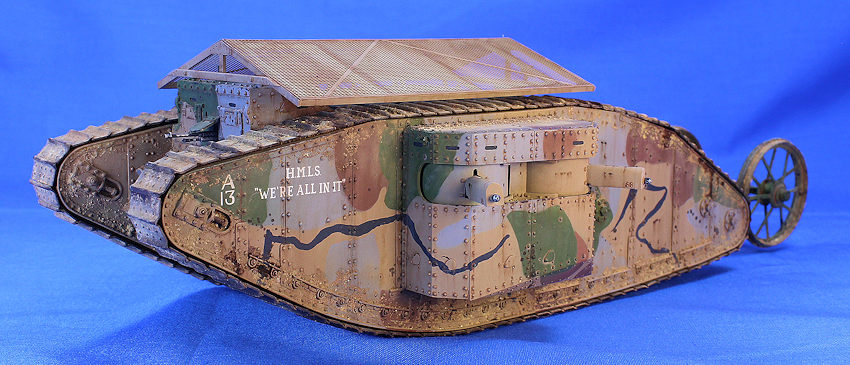
Takom 1/35 Mk.I Female
| KIT #: | 2033 |
| PRICE: | $62.00 SRP |
| DECALS: | Yes |
| REVIEWER: | Scott Lyle |
| NOTES: |

| HISTORY |
In a world that loves “firsts”, the British Mark I tank holds a fairly significant one - the first tank ever to be used in combat.
The Mark I was born of the need to break the stalemate of the trenches that came to dominate the Western Front soon after World War I began. The invention of the machine gun gave tremendous firepower to those in prepared defensive positions, forcing attackers underground for cover. Soon an entire system of trenches stretched across northern France from the English Channel to the foothills of the Swiss Alps. The war devolved into a brutal slogging match of attrition. Commanders schooled in outdated tactics ordered massed infantry charges, only to watch their soldiers get tangled in the enemy’s barbed wire and cut down by machine guns in massive numbers.
 Germany
could afford to take a defensive posture since they firmly occupied northern
French soil. France and Great Britain however did not have this luxury – in
order to expel the enemy from France, they had to attack. When offensive after
offensive failed to produce nothing but unimaginably high casualty lists, the
Allies realized they had to try something different to crack the German lines.
Germany
could afford to take a defensive posture since they firmly occupied northern
French soil. France and Great Britain however did not have this luxury – in
order to expel the enemy from France, they had to attack. When offensive after
offensive failed to produce nothing but unimaginably high casualty lists, the
Allies realized they had to try something different to crack the German lines.
Both Britain and France began developing different machines that they hoped would overcome the trenches. After several failed and fantastical schemes, both sides settled on the basic idea of an armored box on a set of motorized “caterpillar” tracks; a vehicle that could approach and cross the enemy’s trenches under its own power. By the summer of 1915 Britain had built such a prototype, the Number One Lincoln Machine. Outfitted with a large, two-wheeled trolley on the back to help it steer, the vehicle, nicknamed “Little Willie”, performed reasonably well in tests though its trench-crossing ability was deemed insufficient.
To solve the trench-crossing problem a second prototype with large, rhomboid-shaped track frames on either side of the hull was developed. Named “Big Willie”, the prototype was powered by the same 13 liter, 105 hp Daimler engine that had powered Little Willie. While Little Willie had no armament, Big Willie was armed with a Hotchkiss 57mm cannon protruding from a sponson on each side of the hull. The tank was known officially as Her Majesty’s Landship “Centipede”, but it soon came to be known as “Mother”. Compared to Little Willie it was slightly roomier on the inside due to the sponsons and the rearrangement of its mechanicals, but in terms of weight it was much heavier, weighing in at 28 tons compared to its predecessor’s 16.
Mother underwent testing in January 1916, and on February 8 an order was placed for 100 machines. The tank’s construction consisted of angle iron frames to which various armor plates were attached. On the sides the plates were riveted, but on top they were bolted to allow access to the various drivetrain components inside. One serious design flaw was the location of the fuel tanks; two 25 gallon tanks were located up front on either side of the cab where they were particularly vulnerable. The armor plating, 10mm thick in important areas and 6mm everywhere else, was proof only against small arms fire, grenades and shell fragments.
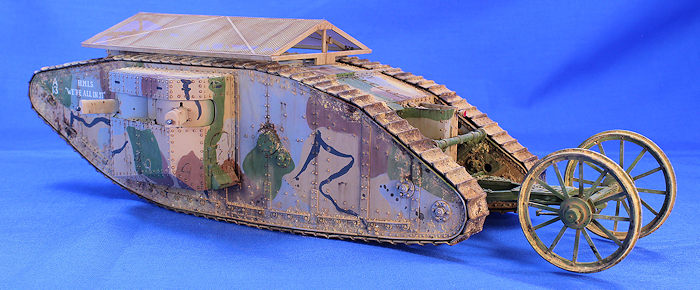 Operating
the tank was about as miserable a human experience as can be imagined. Fully
loaded with ammunition, fuel, oil and the belongings of all eight crew members,
the inside was incredibly crowded. During operation the engine was so loud that
the crew could only communicate by hand signals or by poking each other with
sticks. The temperature inside the tank was typically sweltering, often reaching
120 degrees Fahrenheit. In addition ventilation was very poor, and carbon
monoxide from the engine often made crew members temporarily ill or mentally
unresponsive. Oil, grease, and gasoline fumes, combined with the odor of eight
sweaty crew members added to the suffering. Vision through the small loopholes
and prism slots was very difficult, which meant the tank was often moving
forward basically blind.
Operating
the tank was about as miserable a human experience as can be imagined. Fully
loaded with ammunition, fuel, oil and the belongings of all eight crew members,
the inside was incredibly crowded. During operation the engine was so loud that
the crew could only communicate by hand signals or by poking each other with
sticks. The temperature inside the tank was typically sweltering, often reaching
120 degrees Fahrenheit. In addition ventilation was very poor, and carbon
monoxide from the engine often made crew members temporarily ill or mentally
unresponsive. Oil, grease, and gasoline fumes, combined with the odor of eight
sweaty crew members added to the suffering. Vision through the small loopholes
and prism slots was very difficult, which meant the tank was often moving
forward basically blind.
In combat things only got worse, as firing the various guns added to the heat, noise, and horrific fumes. The quality of the armor plate was so poor that bullets stopped on the outside still created splash - shards of metal that flaked off and went flying around the interior like shrapnel. The enemy soon learned to concentrate their fire on the vision slits, shattering the glass prisms and blinding the crew inside. Finally every tanker’s worst nightmare – fire – was a very real danger in these first tanks. The toxic brew of fumes on the inside meant that a shell that penetrated and exploded often caused a massive fire in seconds. With tiny exit hatches and eight men to escape, a fire quickly became a hellish nightmare of crew members desperately fighting to claw their way out. Many were incinerated as the tank turned into a literal furnace.
The first production models left the factories in June 1916, and the first tanks headed to France on August 13 where the vehicles and their crews began to prepare for combat in mid-September. In fact the first use of tanks in combat was on September 15, 1916, during the Battle of Flers-Courcelette, part of the overall Somme Campaign. While the impact of tanks on the battle was relatively light, British Commander-in-Chief Douglas Haig ordered 1000 more tanks after the battle. The tank was here to stay.
| THE KIT |
Yet another new model company to appear over the last
few years, Takom has quickly developed a reputation for highly detailed,
well-thought out kits of subjects that other companies haven’t tackled,
particularly WW1 armor. Takom’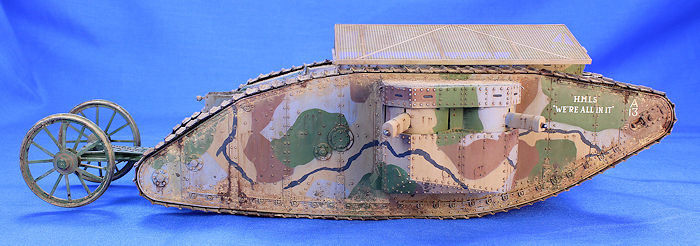 s
Mk. I arrived in 2015 in both the Female and Male versions with different,
thoughtful touches in each. The Male version gives you a trolley for wheeling
around the sponsons that had to be removed from the tank during shipping, while
the Female version gives you a photo etch anti-grenade screen to mount on the
top of the tank. Even better, both versions give you the steering tail sometimes
seen on the tanks, so you can’t say Takom isn’t generous.
s
Mk. I arrived in 2015 in both the Female and Male versions with different,
thoughtful touches in each. The Male version gives you a trolley for wheeling
around the sponsons that had to be removed from the tank during shipping, while
the Female version gives you a photo etch anti-grenade screen to mount on the
top of the tank. Even better, both versions give you the steering tail sometimes
seen on the tanks, so you can’t say Takom isn’t generous.
Opening up the sturdy and fairly big box reveals a plethora of sprues, 15 to be exact, of very nice looking parts molded in light gray plastic. There is a separate bag of brown plastic track links that click together, while another bag contains the instructions, a sprue of black poly-caps, a fret of photo etch, a small sheet of decals, and a full color painting guide by “Ammo from MIG” for three different tanks. One clever touch I haven’t seen from any other manufacturer – the letter that identifies each sprue is molded right through the plastic so it can be seen from either side of the sprue, making identification of the sprues in the box a little easier.
| CONSTRUCTION |
We all know with aircraft you start with the cockpit
and with tanks you start with the suspension, right? As it turns out, this one
starts out a little differently. First you build up the small cabin that is
mounted to the top front of the hull and houses a nicely detailed 8mm Hotchkiss
machine gun. Made up of separate side and top plates, the parts assembled nicely
with tight seams. Next you build the hull itself, a process which consists of
gluing together the several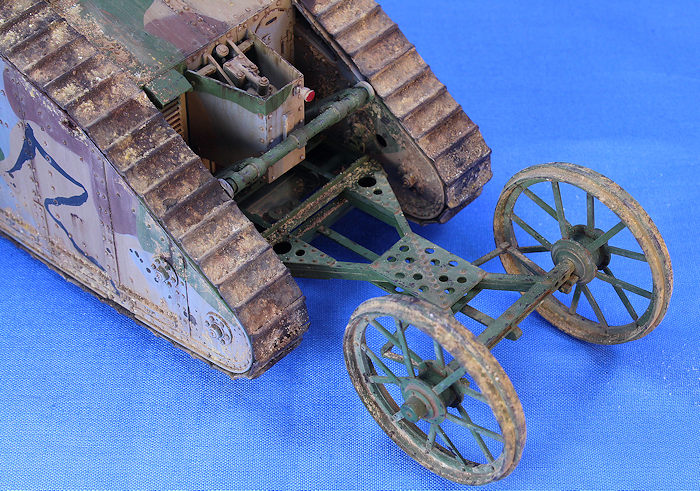 front, top, rear and bottom plates. One tip I learned from another online
reviewer made this step much easier – use one of the track housing sides as a
guide when gluing these plates together. This will assure that all of the angles
of the various plates will be held true. With the track housing side lying flat
I temporarily held each hull plate in place with some tape and then ran Ambroid
ProWeld cement into the joints, making sure not to get any on the track housing
in the process.
front, top, rear and bottom plates. One tip I learned from another online
reviewer made this step much easier – use one of the track housing sides as a
guide when gluing these plates together. This will assure that all of the angles
of the various plates will be held true. With the track housing side lying flat
I temporarily held each hull plate in place with some tape and then ran Ambroid
ProWeld cement into the joints, making sure not to get any on the track housing
in the process.
With that dry the assembly of the two track housings was next. Building these large rhomboid-shaped assemblies was more involved than the hull itself. Between their two halves a whopping 27 bogie wheels, an idler and a drive sprocket must be trapped! Building the 29 sets of wheels took me two nights, but then the real fun began. With one housing half lying flat, I positioned all of the wheels into it without any glue. I then carefully lay the other housing half over the top, trying to trap all of those axles in the process. Some of the axles cooperated and appeared thru their respective holes, but most needed a gentle nudge while a little pressure was kept on the upper housing half. Working from one side to the other I managed to get everything lined up, at which point I eagerly ran liquid cement into the joints of the assembly to button everything up. When it was dry all but one of the 29 wheels was free to rotate – close enough! And if that process wasn’t enough fun, it was time to repeat it on the other side…
With
the hull and both track housings complete, the next steps revolved around
assembling the side sponsons that contained the machine guns. The machine gun
assemblies required a little filler to their armored housings to fill in the
seams, but once dry they then assembled into armored drum-like shields that are
free to rotate on their pedestals, thanks to a polycap. Two such assemblies then
attach to the s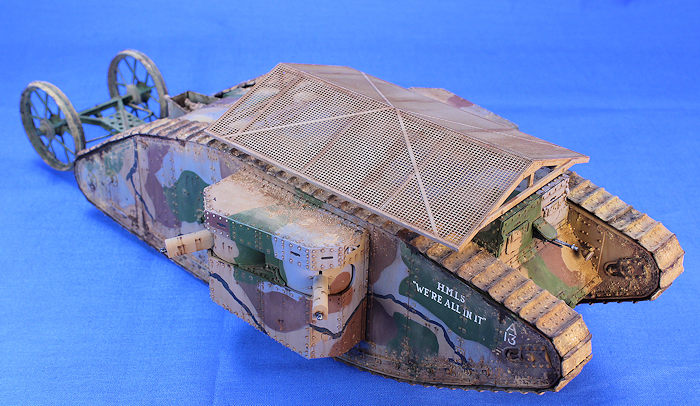 ponson
floor plate, with the rest of the sponson plates fitting all around it to create
the completed sponson assembly. The fit of all the plates gave me no trouble and
needed no filler.
ponson
floor plate, with the rest of the sponson plates fitting all around it to create
the completed sponson assembly. The fit of all the plates gave me no trouble and
needed no filler.
It was now time to put everything together. I first glued both track housings to the hull, which fit very nicely. Ambroid’s glue worked great for these steps; it’s quick drying time proving to be very useful. Next up were the sponsons. One tiny rivet on the bottom plate of each had to be removed, but once it was the sponsons sat flush in their pockets.
The aforementioned steering tail was assembled next, followed by the anti-grenade screen with its delicate photo-etch screens. Leaving those two assemblies and the tracks separate from the tank, I headed to the paint booth.
| COLORS & MARKINGS |
My first painting step was to prime everything with Tamiya’s Liquid Surface Primer and then check the model for any gaps or seams that may need attention. Finding none, I moved onto the paint scheme. The kit provides decals and a painting guide for three different tanks, and I chose to build an “A” company tank with the words “HMLS We Are All In It” on its bow. Apparently the first Mark I’s to go into battle were painted with complex camouflage schemes , but those were quickly done away with once it was realized that the tanks got covered in mud, grime, and dirt, obliterating any patterns underneath. Unfortunately for me however, the complex paint scheme had to be painted. I reached for my old masking friend – Silly Putty.
The first color I applied
was Tamiya XF-67 NATO Green, which was sprayed all over the tank and the
trolley. After it was masked off with Silly Putty, I sprayed the Tamiya XF-64
Red Brown areas next. That was then masked off, and Tamiya XF-19 Sky Gray was
sprayed next, followed lastly by Tamiya XF-78
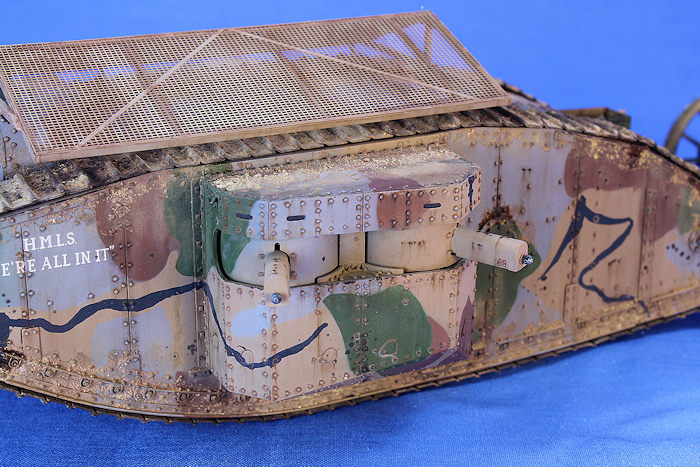 Wooden
Deck Tan. I removed all of the Silly Putty and then touched up any areas that
needed attention by hand. The last step was to paint the black stripes by brush
using Vallejo 862 Black Grey.
Wooden
Deck Tan. I removed all of the Silly Putty and then touched up any areas that
needed attention by hand. The last step was to paint the black stripes by brush
using Vallejo 862 Black Grey.
A couple of decals go on each side of the bow. I hand painted those areas with Testors Gloss, applied the decals, and then airbrushed some Tamiya Flat Finish over them to seal them with something that wouldn’t react with all of the enamel-based weathering that was coming next. By the way, since one of the common complaints of us modelers is that flat finishes are never flat enough, I found the new Tamiya Flat to work very well via airbrush, but not very well via hand brush.
On to the weathering. The first step was to apply a Sin Industries Filter, P246 Grey for Bright Green, over the whole model. That was followed by a pin wash of MIG Productions’ Brown Wash on the lighter colors and their Dark Wash on the Red Brown areas, streaking them downwards on the tank’s vertical surfaces.
At this point I assembled the tracks, which clicked together easily. The instructions would have you assemble 90 links for each side, but I found that 89 was the correct number. I sprayed them with an overall coat of Tamiya XF-10 Brown, and followed that up with a rusty home-made wash. I then mounted them to the tank.
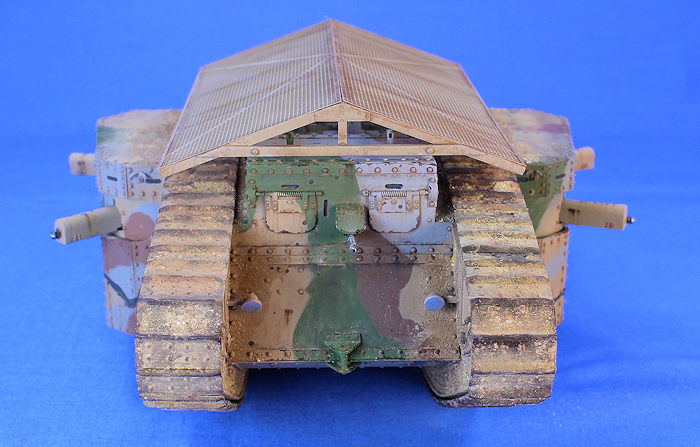 In keeping
with the idea that these early tanks crawled through muddy shell holes and deep
trenches, I applied a heavy amount of MIG Pigments to the tracks and the
horizontal surfaces on either side of the tracks, fixing them in place with
Tamiya’s Acrylic Thinner. I used a couple of different colors to create some
variation. That was followed up with some paint chipping done by hand using
Vallejo German Camouflage Brown, and then some more localized washes were added
to create some vertical stains and streaks. I wanted the tank to look seriously
grubby and dirty even though in all likelihood its life wasn’t longer than a
couple of months.
In keeping
with the idea that these early tanks crawled through muddy shell holes and deep
trenches, I applied a heavy amount of MIG Pigments to the tracks and the
horizontal surfaces on either side of the tracks, fixing them in place with
Tamiya’s Acrylic Thinner. I used a couple of different colors to create some
variation. That was followed up with some paint chipping done by hand using
Vallejo German Camouflage Brown, and then some more localized washes were added
to create some vertical stains and streaks. I wanted the tank to look seriously
grubby and dirty even though in all likelihood its life wasn’t longer than a
couple of months.
The two-wheeled steering trolley was given the same weathering treatment, and then both it and the anti-grenade shield were glued to the tank. After a few final touches, the big, primitive tank was done.
| CONCLUSIONS |
This is one heck of a kit. Well-engineered and highly detailed, Takom are to be commended for creating such a high quality model. It went together quickly and easily, even though some 58 sets of wheels were involved. We are living in a golden age of modeling that a (literally) 100 year old tank gets such a nice treatment. One piece click-together tracks, photo-etch screens – nothing else needs to be purchased.
This model is screaming out to be the centerpiece of a muddy, filthy WWI trench diorama. Highly recommended!
| REFERENCES |
- David Fletcher, Osprey Publishing, New Vanguard #100, British Mark I Tank 1916
1 November 2016
Copyright ModelingMadness.com
If you would like your product reviewed fairly and fairly quickly, please contact the editor or see other details in the Note to Contributors.